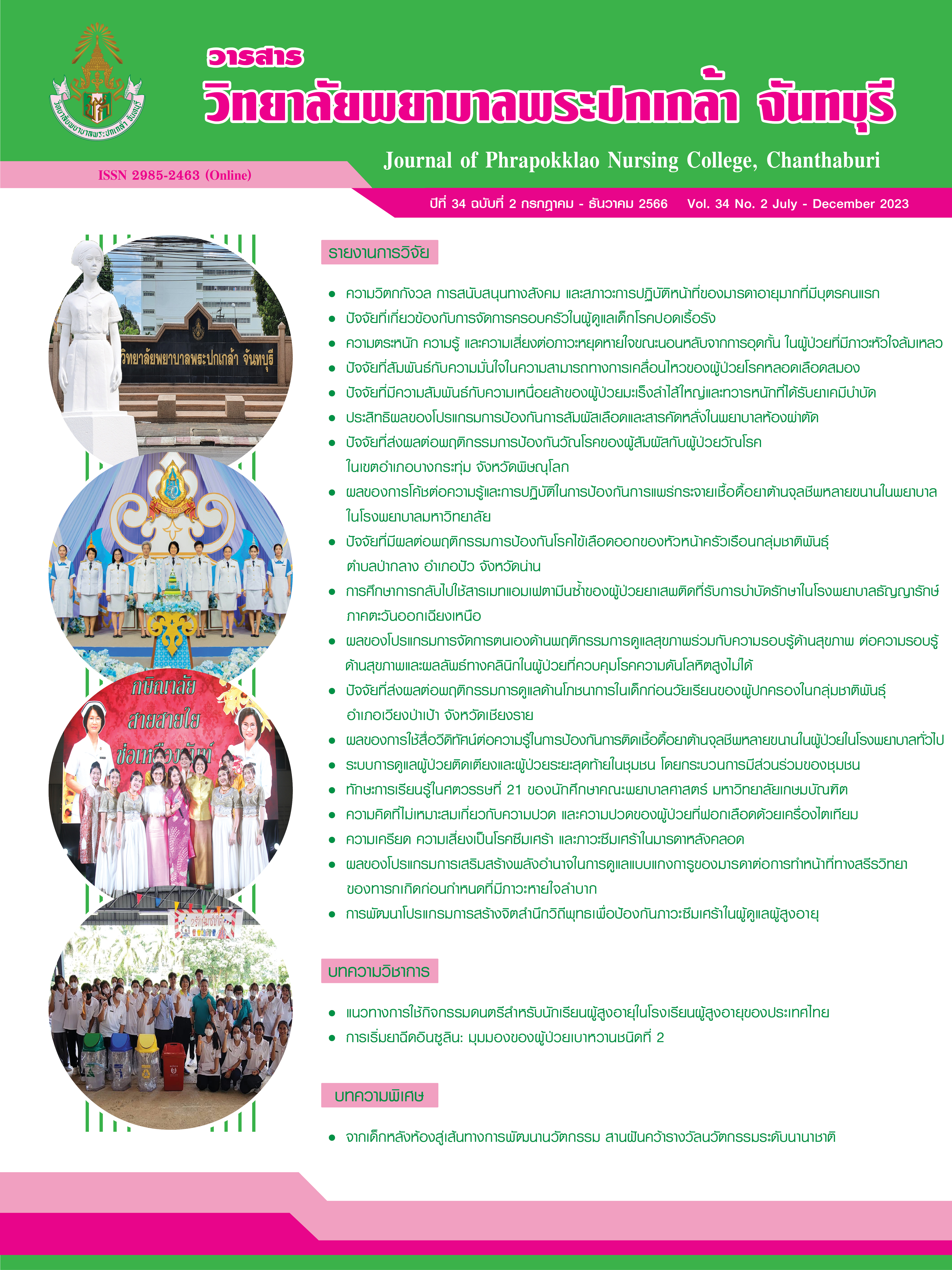A Study of Methamphetamine Relapse among Drug Addict Patients Receiving Therapy in Thanyarak Hospitals, North-eastern Region of Thailand
Keywords:
Methamphetamine relapse, Drug addict patientsAbstract
This descriptive research aimed to study methamphetamine relapse among drug addict patients. The samples consisted of 70 drug addict patients receiving therapy at Thanyarak Udonthani Hospital and Thanyarak Khonkaen Hospital who had methamphetamine relapse. The research instruments included a demographic questionnaire and a methamphetamine relapse questionnaire. Data were collected from November 2019 to January 2020. Statistics used for data analysis included frequency and percentage.
The research results revealed that the drug addict patients had a methamphetamine relapse within 1–6 months (37.14%). The main cause of the methamphetamine relapse was a friend invitation (34.28%). The stress problem that caused the methamphetamine relapse was a lack of financial liquidity (21.42%). In addition, the situations that caused the methamphetamine relapse were obtaining a salary (17.14%) and attending various parties (17.14%).
This research suggests that nurses in Thanyarak Udonthani Hospital and Thanyarak Khonkaen Hospital should transfer the information in this research to nurses in the primary care unit. Then they provide activities to prevent methamphetamine relapse among drug addict patients.
References
ก้องเกียรติ อุเต็น, จารุณี รัศมีสุวิวัฒน์, วิชชุดา ยะสินธุ์, วิมลวรรณ คำลือ, และพุทธชาด ศรีสุวรรณ์. (2565). การพัฒนาโปรแกรมการบำบัดแบบบูรณาการต่อการป้องกันการกลับไปเสพซ้ำในผู้ที่เป็นโรคจิตจากแอมเฟตามีน. วารสารการพยาบาลจิตเวชและสุขภาพจิต, 36(3), 46–70.
กัญญา ภู่ระหงษ์. (2561). ปัจจัยที่มีผลต่อการเสพซ้ำของผู้ติดยาเสพติดในเขตจังหวัดปทุมธานี. วารสารพยาบาลสาธารณสุข, 32(2), 23–40.
ผกามาศ โรยทอง. (2565). ปัจจัยที่ส่งผลต่อการตัดสินใจเสพยาเสพติดของเด็กและเยาวชนที่เข้ารับการบำบัดในสถานบริการจังหวัดภูเก็ต. วารสารศาสตร์สุขภาพและการศึกษา, 2(3), 63–80.
ภัทรินทร์ ธรรมดวงศรี, และศุภรดา วงค์จำปา. (2566). การเสริมสร้างการรับรู้ความสามารถของตนเองในผู้ป่วยสารเสพติดเพื่อป้องกันการกลับไปใช้สารเสพติดซ้ำ. วารสารพยาบาลกระทรวงสาธารณสุข, 33(2), 1–10.
มนฤดี วงศ์จิตรัตน์. (2566). ปัจจัยทำนายความสำเร็จในการหยุดใช้เมทแอมเฟตามีนระหว่างเข้ารับการบริการเมทริกซ์โปรแกรม. วารสารสุขภาพจิตแห่งประเทศไทย, 31(3), 176–189.
รัศมน กัลยาศิริ. (2562). สารกระตุ้นประสาท (stimulants). สืบค้นจาก https://cads.in.th/cads/content?id=78
วรัญญา จิตรผ่อง, วิโรจน์ วีรชัย, และรัศมน กัลยาศิริ. (2554). ความรุนแรงของการเสพสารเมทแอมเฟตามีนซ้ำของผู้กำลังรับการบำบัด ณ สถาบันธัญญารักษ์. จุฬาลงกรณ์เวชสาร, 55(2), 153–169.
ศุภฤกษ์ นาคดิลก. (2563). อุบัติการณ์ของผู้ป่วยที่ใช้สารเมทแอมเฟตามีนซ้ำในสถาบันบำบัดรักษาและฟื้นฟูผู้ติดยาเสพติดแห่งชาติบรมราชชนนี (สบยช.). วารสารวิชาการเสพติด, 6(1), 47–58.
สถาบันบำบัดรักษาและฟื้นฟูผู้ติดยาเสพติดแห่งชาติบรมราชชนนี. (2565). ยาบ้า. สืบค้นจาก http://www.pmnidat.go.th/thai/index.php?option=com_content&task=view&id=156&Itemid=30
สถาบันบำบัดรักษาและฟื้นฟูผู้ติดยาเสพติดแห่งชาติบรมราชชนนี. (2566). สถิติผู้ป่วยทั้งหมดที่เสพยาบ้าเป็นยาเสพติดหลัก และเสพร่วมกับยาอื่นๆ ประจำปีงบประมาณ 2562–2566. สืบค้นจาก http://www.pmnidat.go.th/thai/index.php?option=com_content&task=view&id=4603&Itemid=53
สำนักข่าว กรมประชาสัมพันธ์. (2563). จังหวัดเลย รายงานสถานการณ์ปัญหายาเสพติดในห้วงเดือน ก.ค.–15 ส.ค. 63 พบยังมีการลักลอบนำเข้าในพื้นที่ชายแดนอย่างต่อเนื่อง. สืบค้นจาก https://thainews.prd.go.th/th/news/detail/TCATG200825163555293
สำเนา นิลบรรพ์, บุญเรือง ศรีเหรัญ, และอุษา คงทอง. (2559). ความสัมพันธ์เชิงสาเหตุของปัจจัยที่มีผลต่อพฤติกรรมการเสพยาซ้ำของผู้เสพเมทแอมเฟตามีน. วารสารบัณฑิตศึกษา มหาวิทยาลัยราชภัฏวไลยอลงกรณ์ ในพระบรมราชูปถัมภ์, 10(1), 193–207.
สุทธิชัย ศิรินวล, ปัทมา สุพรรณกุล, ณรงค์ศักดิ์ หนูสอน, และปราโมทย์ วงศ์สวัสดิ์. (2559). ปัจจัยที่ส่งผลต่อการเสพยาบ้าซ้ำของผู้ผ่านการบำบัด. วารสารวิจัยทางวิทยาศาสตร์สุขภาพ, 10(1), 39–45.
Brecht, M. L., von Mayrhauser, C., & Anglin, M. D. (2000). Predictors of relapse after treatment for methamphetamine use. Journal of Psychoactive Drugs, 32(2), 211–220. doi:10.1080/02791072.2000.10400231
Guardian News & Media Limited or its affiliated companies. (2023). Amphetamines affect men more than women. Retrieved from https://www.theguardian.com/science/2006/apr/08/drugs.drugsandalcohol
Hendershot, C. S., Witkiewitz, K., George, W. H., & Marlatt, G. A. (2011). Relapse prevention for addictive behaviors. Substance Abuse Treatment, Prevention, and Policy, 6, 17. doi:10.1186/1747-597X-6-17
Marlatt, G. A., & Donovan, D. M. (Eds.). (2005). Relapse prevention: Maintenance strategies in the treatment of addictive behaviors (2nd ed.). New York: Guilford Press.
Downloads
Published
How to Cite
Issue
Section
License
Copyright (c) 2023 Journal of Phrapokklao Nursing College, Chanthaburi

This work is licensed under a Creative Commons Attribution-NonCommercial-NoDerivatives 4.0 International License.
เนื้อความ ข้อมูล และรายการอ้างอิงที่ผู้เขียนใช้ในการเขียนบทความเพื่อลงตีพิมพ์ในวารสารวิทยาลัยพยาบาลพระปกเกล้า จันทบุรี ถือเป็นความคิดเห็นและความรับผิดชอบของผู้เขียน คณะผู้จัดทำวารสารไม่จำเป็นต้องเห็นพ้องด้วยหรือร่วมรับผิดชอบ
บทความที่ได้รับการลงตีพิมพ์ในวารสารวิทยาลัยพยาบาลพระปกเกล้า จันทบุรี ถือเป็นลิขสิทธิ์ของวารสารวิทยาลัยพยาบาลพระปกเกล้า จันทบุรี หากหน่วยงานหรือบุคคลใดต้องการนำส่วนหนึ่งหรือทั้งหมดของบทความไปเผยแพร่ต่อเพื่อวัตถุประสงค์ใด ๆ จะต้องได้รับอนุญาตจากบรรณาธิการวารสารก่อน



